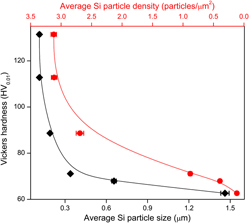Crossref Citations
This article has been cited by the following publications. This list is generated based on data provided by
Crossref.
Sun, Shaobo
Zheng, Lijing
Liu, Yingying
Liu, Jinhui
and
Zhang, Hu
2015.
Characterization of Al–Fe–V–Si heat-resistant aluminum alloy components fabricated by selective laser melting.
Journal of Materials Research,
Vol. 30,
Issue. 10,
p.
1661.
Tang, Ming-Kai
Huang, Xing-Jiu
Guo, Zheng
Yu, Jin-Gui
Li, Xue-Wu
and
Zhang, Qiao-Xin
2015.
Fabrication of robust and stable superhydrophobic surface by a convenient, low-cost and efficient laser marking approach.
Colloids and Surfaces A: Physicochemical and Engineering Aspects,
Vol. 484,
Issue. ,
p.
449.
Attar, H.
Prashanth, K.G.
Chaubey, A.K.
Calin, M.
Zhang, L.C.
Scudino, S.
and
Eckert, J.
2015.
Comparison of wear properties of commercially pure titanium prepared by selective laser melting and casting processes.
Materials Letters,
Vol. 142,
Issue. ,
p.
38.
Chou, R.
Milligan, J.
Paliwal, M.
and
Brochu, M.
2015.
Additive Manufacturing of Al-12Si Alloy Via Pulsed Selective Laser Melting.
JOM,
Vol. 67,
Issue. 3,
p.
590.
Chaubey, Anil
Konda Gokuldoss, Prashanth
Wang, Zhi
Scudino, Sergio
Mukhopadhyay, Nilay
and
Eckert, Jürgen
2016.
Effect of Particle Size on Microstructure and Mechanical Properties of Al-Based Composite Reinforced with 10 Vol.% Mechanically Alloyed Mg-7.4%Al Particles.
Technologies,
Vol. 4,
Issue. 4,
p.
37.
Tang, Ming-Kai
Huang, Xing-Jiu
Yu, Jin-Gui
Li, Xue-Wu
and
Zhang, Qiao-Xin
2016.
The Effect of Textured Surfaces with Different Roughness Structures on the Tribological Properties of Al Alloy.
Journal of Materials Engineering and Performance,
Vol. 25,
Issue. 10,
p.
4115.
Gokuldoss Prashanth, Konda
Scudino, Sergio
and
Eckert, Jürgen
2016.
Tensile Properties of Al-12Si Fabricated via Selective Laser Melting (SLM) at Different Temperatures.
Technologies,
Vol. 4,
Issue. 4,
p.
38.
Antony Vasantha Kumar, C.
Selwin Rajadurai, J.
and
Sundararajan, S.
2016.
Performance enrichment on tribological characteristics of powder metallurgy processed aluminium particulate composites by inclusion of rutile (TiO2).
Journal of Materials Research,
Vol. 31,
Issue. 16,
p.
2445.
Prashanth, Konda G.
Scudino, Sergio
Chaubey, Anil K.
Löber, Lukas
Wang, Pei
Attar, Hooyar
Schimansky, Frank P.
Pyczak, Florian
and
Eckert, Jürgen
2016.
Processing of Al–12Si–TNM composites by selective laser melting and evaluation of compressive and wear properties.
Journal of Materials Research,
Vol. 31,
Issue. 1,
p.
55.
Sander, J.
Hufenbach, J.
Giebeler, L.
Wendrock, H.
Kühn, U.
and
Eckert, J.
2016.
Microstructure and properties of FeCrMoVC tool steel produced by selective laser melting.
Materials & Design,
Vol. 89,
Issue. ,
p.
335.
Zhu, Y.
Chen, X.
Zou, J.
and
Yang, H.
2016.
Sliding wear of selective laser melting processed Ti6Al4V under boundary lubrication conditions.
Wear,
Vol. 368-369,
Issue. ,
p.
485.
Chang, Kun
and
Gu, Dongdong
2016.
Direct metal laser sintering synthesis of carbon nanotube reinforced Ti matrix composites: Densification, distribution characteristics and properties.
Journal of Materials Research,
Vol. 31,
Issue. 2,
p.
281.
Wang, P.
Li, H.C.
Prashanth, K.G.
Eckert, J.
and
Scudino, S.
2017.
Selective laser melting of Al-Zn-Mg-Cu: Heat treatment, microstructure and mechanical properties.
Journal of Alloys and Compounds,
Vol. 707,
Issue. ,
p.
287.
Wang, Z.
Scudino, S.
Prashanth, K.G.
and
Eckert, J.
2017.
Corrosion properties of high-strength nanocrystalline Al 84 Ni 7 Gd 6 Co 3 alloy produced by hot pressing of metallic glass.
Journal of Alloys and Compounds,
Vol. 707,
Issue. ,
p.
63.
Prashanth, K.G.
Damodaram, R.
Maity, T.
Wang, P.
and
Eckert, J.
2017.
Friction welding of selective laser melted Ti6Al4V parts.
Materials Science and Engineering: A,
Vol. 704,
Issue. ,
p.
66.
Prashanth, Konda
Scudino, Sergio
Chatterjee, Riddhi
Salman, Omar
and
Eckert, Jürgen
2017.
Additive Manufacturing: Reproducibility of Metallic Parts.
Technologies,
Vol. 5,
Issue. 1,
p.
8.
Ma, Pan
Jia, Yandong
Konda Gokuldoss, Prashanth
Yu, Zhishui
Yang, Shanglei
Zhao, Jian
and
Li, Chonggui
2017.
Effect of Al2O3 Nanoparticles as Reinforcement on the Tensile Behavior of Al-12Si Composites.
Metals,
Vol. 7,
Issue. 9,
p.
359.
Prashanth, K. G.
Scudino, S.
Maity, T.
Das, J.
and
Eckert, J.
2017.
Is the energy density a reliable parameter for materials synthesis by selective laser melting?.
Materials Research Letters,
Vol. 5,
Issue. 6,
p.
386.
Gokuldoss, Prashanth Konda
Kolla, Sri
and
Eckert, Jürgen
2017.
Additive Manufacturing Processes: Selective Laser Melting, Electron Beam Melting and Binder Jetting—Selection Guidelines.
Materials,
Vol. 10,
Issue. 6,
p.
672.
Prashanth, K.G.
Scudino, S.
and
Eckert, J.
2017.
Defining the tensile properties of Al-12Si parts produced by selective laser melting.
Acta Materialia,
Vol. 126,
Issue. ,
p.
25.





